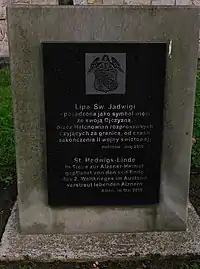Alzenau dialect
Halcnovian (Altsnerisch/Päurisch), alternatively spelled Haltsnovian, is a West Germanic dialect spoken in the former village of Hałcnów, which is now a district of Bielsko-Biała, Poland. It was the vernacular language of Hałcnów until 1945, when those thought to be ethnic Germans were expelled from Poland. Some examples of the language were recorded in the works of Karl Olma (1914-2001), who was active as a journalist in the Halcnovian exile community in West Germany after the II World War.[1] Recently the dialect has been researched from a linguistic standpoint by Marek Dolatowski.[2][3] It is related to the Wymysorys language.[4]

| Halcnovian | |
|---|---|
| Haltsnovian | |
| Altsnerisch / Päurisch | |
| Native to | Poland |
| Region | Hałcnów |
Native speakers | 8 (2015) Including passive users |
| Language codes | |
| ISO 639-3 | – |
Sample text
Ma hīrt guor oft di Loit huort kluoin
do hoit-zotāg werd veil geloin
an wār nė güt betrīga kon,
dos ei kai ōgefāner Mōn.
Do lōw ėch mir di ālde Welt
di wuor of andre Fis geštelt.
See also
Sources
- Mętrak, Maciej (2019). "Wymysorys (Vilamovicean) and Halcnovian: Historical and Present-Day Sociolinguistic Situation of Microlanguages in a Southern-Polish Language Island". The Slavs from the Turn of 19th and 20th Centuries Until Now: Linguistic, Historical and Political Changes and Literature: 7–19.
- Dolatowski, Marek (2013). "Słownictwo hałcnowskie jako odbicie historii etnolektu i historii wsi" (PDF). Kwartalnik Językoznawczy. 3: 1–10.
- Dolatowski, Marek (2015). "Pochodzenie etnolektu hałcnowskiego w świetle fonetyki i fonologii historycznej". Acta Universitatis Lodziensis. Studia Indogermanica Lodziensia. 4. doi:10.18778/1506-7254.04.03.
- "hałcnowski i bielsko-bialska wyspa językowa". inne-jezyki.amu.edu.p (in Polish). Dziedzictwo językowe Rzeczypospolitej. 2014. Archived from the original on 6 October 2014. Retrieved 18 March 2016.